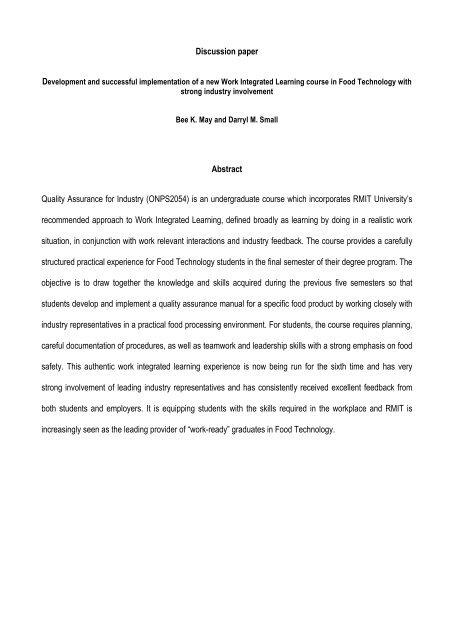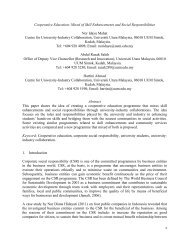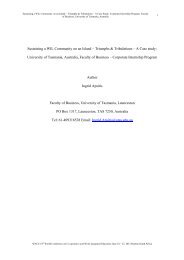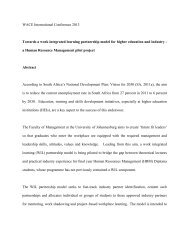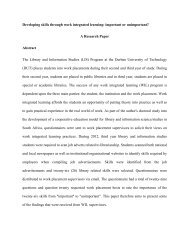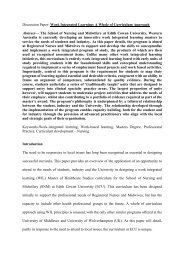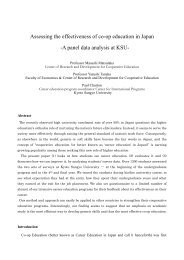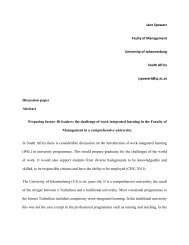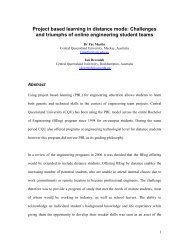Bee K. May, RMIT University; Darryl M. Small (Discussion ... - WACE
Bee K. May, RMIT University; Darryl M. Small (Discussion ... - WACE
Bee K. May, RMIT University; Darryl M. Small (Discussion ... - WACE
- No tags were found...
Create successful ePaper yourself
Turn your PDF publications into a flip-book with our unique Google optimized e-Paper software.
<strong>Discussion</strong> paperDevelopment and successful implementation of a new Work Integrated Learning course in Food Technology withstrong industry involvement<strong>Bee</strong> K. <strong>May</strong> and <strong>Darryl</strong> M. <strong>Small</strong>AbstractQuality Assurance for Industry (ONPS2054) is an undergraduate course which incorporates <strong>RMIT</strong> <strong>University</strong>’srecommended approach to Work Integrated Learning, defined broadly as learning by doing in a realistic worksituation, in conjunction with work relevant interactions and industry feedback. The course provides a carefullystructured practical experience for Food Technology students in the final semester of their degree program. Theobjective is to draw together the knowledge and skills acquired during the previous five semesters so thatstudents develop and implement a quality assurance manual for a specific food product by working closely withindustry representatives in a practical food processing environment. For students, the course requires planning,careful documentation of procedures, as well as teamwork and leadership skills with a strong emphasis on foodsafety. This authentic work integrated learning experience is now being run for the sixth time and has verystrong involvement of leading industry representatives and has consistently received excellent feedback fromboth students and employers. It is equipping students with the skills required in the workplace and <strong>RMIT</strong> isincreasingly seen as the leading provider of “work-ready” graduates in Food Technology.
curriculum. The components are lectures, workshops, fine-tuning practical sessions followed by a practicescale-up session before the production run and final assessment which is carried out in direct partnership withindustry. We achieved this by using the pilot plant at <strong>RMIT</strong> as a “factory” where students become engaged asemployees in the mass production of a high quality, safe food product and where assessments are carried outin partnership with experienced industry personnel.Our model of WIL, used for ONPS2054, is aimed at integrating Contextual Learning which contributes tostudent learning (McLennan, 2008) with Supervised Experience and to draw on these work experiences whenback in the classroom as outlined in Figure 1. The “context” is provided by the pilot plant, which is set up asclosely as possible to a real-life production environment. Students, working in teams, participate in “contextuallearning” in the pilot plant during both the development and production stages. Each team brings their “real lifeexperience” into the classroom by Supervised Experience, which occurs in the development and productionstages (Figure 1). Professional practice is an integral aspect of the course as is assessment by industry andfacilitator.This unique model produces students who are proactive in their learning, especially as they can see where toapply this learning in their career. The approach motivates and inspires the students to learn as demonstratedby 83% of the students who agreed or strongly agreed that “I can see how I’ll be able to use what I am learningin this course in my career”. In addition, the strong industry presence in their learning and exposure to currentindustry practices enhances employability, providing marketable job skills as well as clarification of career goals.Many students have given very positive feedback on this course particularly after they have commenced work inthe industry. One example is that provided by an international student:“…The work integrated learning (WIL) component of this subject is an excellent way to expose studentsto the system frequently used by the food industry to manufacture food products to the highest safety andquality standards. In a world where practical experience is much more important than theory, this subjectprovides a great practical experience for students whom mostly have very limited contact with the food3
Our command of the field, as reflected by the curriculum development and resources is evidenced by the highnumber of graduates who are highly sought after and offered jobs as Quality Assurance Officers within a fewmonths of graduation and, in some cases, as a Quality Assurance Manager in the food industry. As one recentgraduate wrote:“…Thank you very much. I have learned a lot from the course. The QA course successfully helped me insetting up quality plans and achieving HACCP certification for the business… has prepared me well forthis job…the details required from developing the manual was exactly what the industry expected …greatpractice and preparation for the industry…”In terms of benefits to the food industry, we are training future employees with a high level of competence asdemonstrated by the excerpt below of feedback from an industry consultant:“…<strong>RMIT</strong> food technology graduates are invariably ‘first’ choice; even final year students are constantlybeing sought initially for part-time positions. In contrast, current food science graduates from otherVictorian universities working in the QA departments of food companies fail to demonstrate similarcompetence in QA as they have had no practical training in this discipline included in their degrees…”Development of students as individualsWhen the staff of the Food Science discipline were first given the responsibility, in 2006, of designing anddeveloping ONPS2054 as a new course for a new degree program in Food Technology (involving a reductionfrom a 4- to a 3-year degree), we realised the task would be very challenging and this was confirmed by therelatively low Good Teaching Score of only 45.7% for our first attempt! We knew we had to listen and learn fromthe students. In listening, especially through the many interactions we had with students in class, duringpractical sessions, workshop discussions, the formal Student Staff Consultative Committee and incidentalconversations, we learnt that one key missing ingredient with our approach in designing this course was toprovide support for the development of students as individuals. The needs of each type of learner needed to beaccommodated. A particular issue was that the class included a high proportion of international students(approximately 50%), from many and varied backgrounds, having specific needs and requiring appropriate5
espect and support. We have also found that the key factor in determining the satisfaction levels of students inthis course is their experience of teamwork. For example, a group of 3-4 individuals trying to work together for13 weeks, where a high degree of interactions and tight time-lines are expected, can readily cause unpleasantconflict. We actively encourage and support the contribution of each student to the resolution of such difficultiesas would be done by teams and good managers in industry situations.Mastering people skills and learning to work as a team is a life-long experience and this course provides only ataste of what these students will encounter when they enter the work force. From the outset, we haveendeavoured to address team issues by providing documented examples of those experienced by teams inprevious years and providing strategies of how to address these issues during a workshop session. Inparticular, we emphasise the importance of mutual respect by formulating a “Team Learning-in-Action Contract”in which each individual states their expectations, agrees on a set of team values and keeps a weekly reflectivejournal on how they have handled people-skills issues. Students are encouraged to review this Team Learningin-ActionContract on a regular basis. In the operation of this course, it is made clear that “free-rider” behaviouris not accepted by staff and most students actively support this. In order to provide strong reinforcement, andwith strong student support, each individual is required to submit a confidential peer evaluation form at the endof the semester. This allows confidential identification of other team members who have not contributed fully tothe achievements of the group. This provides further incentive to contribute and assessors have a means todeduct marks from students who attempted to minimise their input, thereby effectively overcoming one of thecommon problems encountered in group work.In the evaluation surveys completed each year by the students, the Good Teaching Score improved significantlyfrom 2006 and over the previous three years (2008, 2009 and 2010) to an average of around 76% (Table 1).However, it is important to bear in mind that these surveys were taken around week 10 of the semester whenthe students had not experienced the highly empowering feeling of successfully producing a safe product basedon the QA manual they have developed. In addition, the final part of the performance was to face the industrypanel with their finished product and QA manual in the final assessment in week 13. We were confident that theGood Teaching Score and Overall Satisfaction Index would increase further if the students were to evaluate the6
course after they had completed all aspects of the course. This occurred in 2011 and both the Good TeachingScore and the Overall Satisfaction Index increased substantially (to 84.1 and 93.5% respectively).Assessment and feedbackDuring week 1 of the semester each student is provided with a ten-page document which clearly definesintended learning outcomes, including the generic capabilities. Assessment is also fully described and is closelyaligned with both the intended outcomes and the practical experiences that the students carry out. However,there is also flexibility for recognition to be given for additional innovative efforts by the students, so thatalthough they are provided with a formulation for the product they are to produce, if they refine or enhance thisduring their practical sessions then the marking can take account of the initiative shown.As an example of the approach to assessment, one of the aims of the course is to evaluate the ability of eachteam to identify problems during fine-tuning sessions (carried out in the pilot plant) and to propose short or longterm solutions as appropriate to demonstrate their understanding of the processes involved. Each team isassessed on key aspects of the HACCP principles for making a safe and consistent product, and is alsoencouraged and required to identify limitations of the facilities available within the pilot plant and proposepotential solutions. In particular they have to pay attention to compliance with food safety and hygieneprinciples, as well as with OH&S practices, and show a command and good comprehension of food scienceprinciples.We encourage students to be proactive and show initiative and interest in both their own and team learning. Forexample, in Week 8 where the instructors have the first interview with each group, we provide feedback on thestatus of their manual and also whether they are on track to progress to the next stage where their allocatedproduct is to be mass produced. The impact of the feedback on student learning was that those who were doingwell were encouraged to do even better while those who needed to “get their act together” were motivated toput more effort into improving their manual. In our experience, no group wants to miss out on the massproduction of their product. The positive impact of the feedback is clearly demonstrated in the responses ofstudents to the formal Course Evaluation Surveys (Table 1). These surveys are carried out independently of7
teaching staff each year and the trends reflect the efforts made to refine the course since it was first presentedin 2006. The positive responses of students regarding feedback (question 5 on the surveys) improved from 39to 75%. This is particularly significant as it occurred when the numbers of students in the class rose from 39 to63; and we had to provide effective feedback within an ever decreasing staff time. In addition to the feedback inweek 8, we provided feedback for the class as “common mistakes observed”, after each fine-tuning session.These were posted on the website for this course and students found the feedback particularly helpful as itincreased awareness by highlighting areas for improvement before the mass production run and the associatedassessment.The teaching staff are facilitators who provide students with knowledge during the lectures and assist them indrawing their own links and arriving at their own understanding especially during the workshop sessions. Oftenwe act as enablers where we provide contextual examples of application of principles in an industryenvironment. A key feature of Quality Assurance for Industry (ONPS2054) is that students undertake and areassessed on a structured activity, which is based on the development of a procedures manual for a specificfood product in workshop sessions followed by implementation of a scaled-up production to evaluate the clarityand transparency of the documentation and finally the very proud moment for the students when the groupfinally produces their finished food product. One of the most exciting experiences for the students is having aface-to-face interview with the industry panel; feedback from industry is integral to each student’s learningexperience.ConclusionWe have described how our undergraduate offering Quality Assurance for Industry has been designed as a WILcourse, based on the model of integrating Contextual Learning with Supervised Experience and to draw onthese work experiences when students subsequently returned to the classroom. Our model of WIL hasconsistently achieved excellent student learning outcomes with highly positive industry feedback.8
Acknowledgements Many people have provided support and contributed to the development andimplementation of the WIL course. We are particularly grateful to the Program Advisory Committee(representing various parts of the food industry), for their encouragement and participation, to Soonlee Eu whohas provided industry involvement over the last three years of this course, to Prue Bramwell who presentslectures in some aspects of the course (<strong>RMIT</strong>) and to Lillian Chung (<strong>RMIT</strong>) for her role in facilitating thepractical sessions of the course.ReferencesMcLennan, B., 2008. Work Integrated Learning (WIL) in Australian universities: The challenges of mainstreaming.Paper presented at the Career Development Learning – Maximising the Contribution of Work Integrated Learning tothe Student Experience NAGCAS Symposium, Melbourne.Murphy, G., Calway, B., 2006. Education for professionals through work-integrated learning. Paper presented at theAARE National Conference, Adelaide. Retrieved Dec 2011 from http://www.aare.edu.au/06pap/mur06334.pdf.Patrick, C., Peach, D., Pocknee, C., Webb, F., Fletcher, M., Pretto, G., 2009. The WIL Report: Work IntegratedLearning: A National Scoping Study [Australian Learning and Teaching Council (ALTC) Final report]. Brisbane:Queensland <strong>University</strong> of Technology. Available online at: www.altc.edu.au and www.acen.edu.auRadinsky, J., Bouillion, L., Hanson, K., Gomez, L., Vermeer, D., Fishman, B., 1998. A framework for authenticity:Mutual benefits partnerships. Paper presented at the annual meeting of the American Educational ResearchAssociation, San Diego, CA.<strong>RMIT</strong> <strong>University</strong>, 2008. Work Integrated Learning at <strong>RMIT</strong>: Current practices and recommendations for the future.Retrieved from http://mams.rmit.edu.au/ug8xeqo7tdvx.doc9
Figure 1: A schematic representation of the operation of the <strong>RMIT</strong> Work-Integrated Learning course for Food Technology10
Table 1: A summary of key responses of students in the Course Evaluation Surveys since the commencement of theWIL course at <strong>RMIT</strong>Surveys conducted in class byan admin staff in week 10Surveys conducted onlineat the end of the semester2006 2010 2011Number of surveys completed 39 63 47Student enrolment 42 66 60Good Teaching Score (%) 45.7 76.4 84.1Overall Satisfaction Index (%) - 80.3 93.5Q5 (The teaching staff normally give mehelpful feedback on how I am going in thiscourse) (%)Q18 (I can see how I’ll be able to use what Iam learning in this course in my career) (%)39 75 8574 83 96Note: Responses represent the proportion of students providing positive answers. The Good TeachingScore is composited from responses to a series of questions regarding teaching.11


